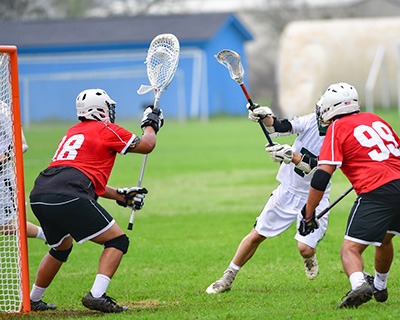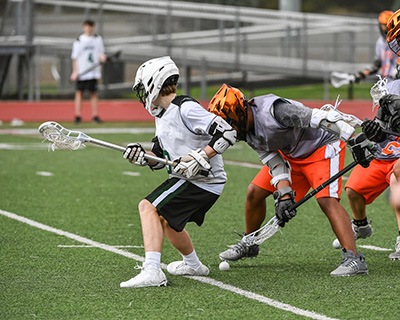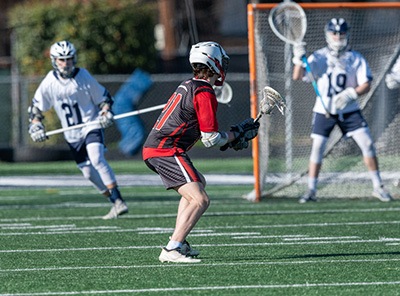There are two main types of checking in lacrosse: body checking and stick checking.
Body checking refers to a defender using his body to make direct contact with the opponent when trying to regain possession of the ball. Stick-check refers to a defender using his stick to poke or lift the opponent's stick.
Stick-check has four different types: lift check, slap check, poke check, and trial check.
This article covers all you must know about slap-check techniques. We discuss the main aim of the slap check, the standard you must follow, and how to use the technique legally.
More...
Take Away Key Points:
Slap Check as a Most Popular Defense Method: All You Need to Know
This is the most popular and effective check by defensive men's lacrosse players. However, there are some rules you cannot violate; otherwise, you might cause penalties.
Read below to get a clearer picture.
What is a slap check in men's lacrosse?

A slap check is an excellent way for defense lacrosse players to take the ball away from their opponents. The check involves lightly slapping the opponent's hands or their stick. The check is usually on the top of their handle.
The defender prevents the attacker during the game in a controlled manner, causing the opponents to knock their sticks out of their hands and allowing his team to win possession.
Slap checks can be a useful tool for defenders that don't have the speed or agility to keep up with their opponents.
What's the main purpose of slap checks?
The purpose of slap checks is twofold:
Defense lacrosse players should use slap checks when guarding an attacker with a loose stick or when there is no danger of an opponent getting hurt by certain types of contact.
Players should also remember that this type of check violates most rules if done too aggressively. Knowing how to use it within legal expectations helps ensure fair play.
When can a defender use a slap check?

Slap checks may only be used by defenders when they are within five yards of the player they are defending and must be performed with an open hand.
Furthermore, no contact is allowed while performing this defensive move.
What are the consequences of aggressive slap checks?
The penalty for a men's lacrosse player who violates rules with a slap check can vary depending on the level of play. In most cases, the offending player will be charged with a personal foul and required to serve a minute-long suspension away from the competition (slashing penalties).
Slashing penalties might be called for unintentionally hitting your opponent's side or back when a defender tries to slap their hands. So, the defense should always focus on checking the opponent's hands and stick.
If the violation is particularly egregious, then the strictest possible measure of punishment may be taken. These could result in ejection and disqualification from the game.
In addition, youth leagues tend to work with softer penalties, while higher leagues may enforce stricter measures due to the physical nature of such violations. Either way, all players must be cautious when attempting any slap-check move. They must ensure that no rules are broken and potentially embarrass or injure another player or themselves.
Benefits of the slap checks
Here are some of the crucial benefits slap-checking offers in lacrosse:
Challenges of the slap checks
Some of the biggest challenges the technique might cause are:
What Are Other Alternatives to the Checks in Lacrosse?

As previously mentioned, the two big groups include: body checks, and stick checks.
Body checks are famous shoulder-to-shoulder contacts. These are allowed above the waist and below the shoulders. You cannot hurt the head or legs of the attacker, an opponent who is three yards from the ball, or the attacker who has possession. You cannot make contact with the opponent from behind.
Stick check only includes minimum contact - stick to stick. As soon as you hit the opponent with your stick, you will cause a foul.
There are three other variants of the stick check, and you can find the details below:
1. Poke check
When poking, your main target is the bottom part of the shaft or the opponent's hand. You will use the head part of your stick to ensure he loses possession.
As you are using the head part of the stick, performing a poke check even when you're a bit far from your opponent is still possible.
2. Lift check
To perform a lift check successfully, you must correctly lift the opponent's bottom hand using your stick. It often results in your opponent losing the possession, which creates a ground ball opportunity.
Long stick middies are prone to lift checking since their sticks have better reachability.
3. Trail check
If your opponent passes you as a last-ditch effect, you can attempt a trail check by attacking the opponent's lacrosse head from behind. You can easily perform it when your opponent is hanging his crosse.
But, the check involves many risks, as you stand a good chance of hitting the opponent's helmet and causing a foul.
READ MORE
FAQs
When can you stick check in lacrosse?
You can stick heck in lacrosse only when you're within five yards of the lost possession. You cannot stick check in off-ball situations.
How do you check a slap?
You check a slap by lightly slapping at your opponent's hands and sticks. They will lose their grip and knock their sticks out of their hands.
Conclusion
With these lacrosse slap check tips, you can properly execute a slap check and prevent the other team from scoring. Remember to keep your stick on their gloves, not their wrists, and use the bottom hand when checking.
Use these techniques next time you play lacrosse and see how they help improve your game!
